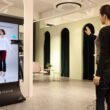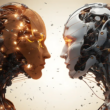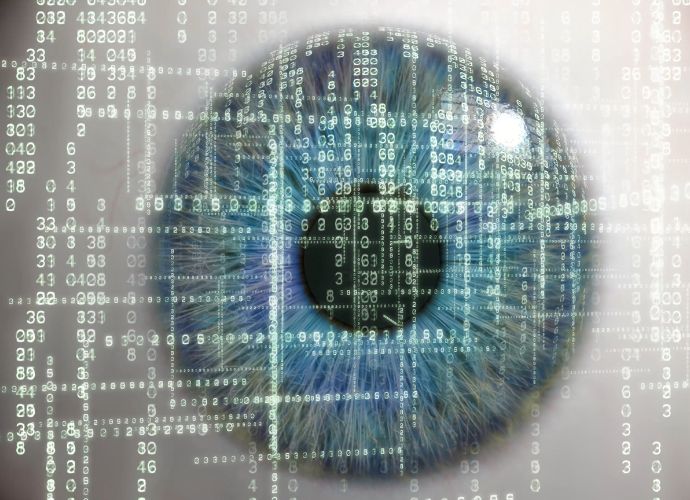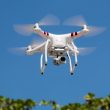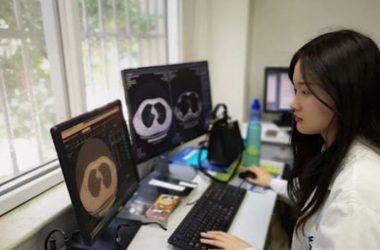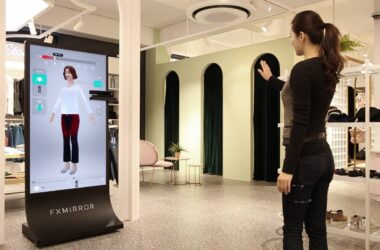The interpretation of pictures and videos is what computer vision in healthcare is all about. The global healthcare and life sciences industries have seen a fast shift in recent years, driven by advances in contemporary technology. With the help of technological advancements like Computer Vision and Artificial intelligence, diagnosing ailments, finding treatments, and proposing preventative actions have gotten much easier.

AI-enabled technologies have significantly improved healthcare standards. This is where computer vision, a branch of AI, comes into play. So how does computer vision aid the healthcare industry? In this essay, let’s determine the answer.
What is Computer Vision in Healthcare?
The relationship between robots and people is being revolutionized by computer vision, a relatively new AI technology. This research aims to develop intelligent computer algorithms that can comprehend and analyze visual input without having to be explicitly programmed in a certain language or program. As long as we only rely on our senses, physicians are responsible for inspecting and diagnosing illnesses and other health problems. What they perceive with their eyes, hearing, and touch will determine the outcome.
Only how human sight and intellect see reality can be considered perception. Computers can now view, examine, and comprehend visual data thanks to computer vision (CV). Additionally, computer vision performs better with more factual data.
According to researchers, images make up to 90% of all input data used in healthcare. It creates several prospects for enhancing patient care and the effectiveness of the healthcare sector through training computer vision algorithms.
In other words, automating procedures that rely on picture identification can improve treatment while requiring less input from people. This is a top priority since it will free medical personnel to concentrate on more complicated issues. Visual analytics have been used extensively to enhance human capacities. But there’s still more to come.
The Benefits of Computer Vision in the Healthcare Sector?
Any medical task that requires a skilled eye to identify and categorize a health issue may be effectively supported by computer vision. This AI-supported system scans images in real-time while processing them using sophisticated algorithms to help identify particular symptoms of sickness.
how computer vision is used in medical applications? it may assist shorten the time wasted on pointless diagnostic tests and provide the medical professional the tools they need to order more precise diagnoses and successful treatments. Computer vision has developed to the point where it can now assist with a variety of medical duties and cover a wide range of jobs. Numerous benefits have been brought about by these innovations, which an increasing number of professionals may benefit from.
Here Are the Different Benefits of Computer Vision in Healthcare
Reliable Image Analysis
Medical image analysis calls for quick and precise analysis. Computer vision succeeds on both counts since it can identify patterns that aid in the earlier diagnosis of illnesses by doctors. In healthcare, computer vision also limits the potential for human mistakes. By analyzing mammograms, AI-based visual systems are skilled at detecting breast cancer. They also allow for quick analysis, which is essential for spotting diseases early.
Contemporary operating rooms
Systems for keeping an electronic health record (HER) can be laborious, particularly when recording surgical operations. It necessitates a lot of human input, frequently resulting in mistakes and delays. Computer vision solves this issue by automating the observation and recording of the whole process.
Using this technology, medical professionals may do away with tedious manual labor and devote more time to patient care.
Better patient Identification
Healthcare institutions frequently see instances of patent identity errors. These instances are typically detected early, but they are still dangerous. If it is not identified, patients receiving incorrect care and drugs might die. Their health may deteriorate, and it may cause additional problems.
Additionally, these mistakes may result in hospitals facing millions-dollar of legal damage claims and a resulting loss of reputation. All these issues are solved in the healthcare industry using computer vision.
Better Healthcare Safety
Compared to other private sector businesses, hospitals experience a higher rate of work-related illnesses and injuries. The majority of injuries frequently result from medical personnel malpractice. They are not required to employ safety gear or adhere to the established procedures for safe operations.
Unavoidable errors may also occur, although they may be avoided using technology properly. Visual systems powered by AI and computer vision notify the appropriate authorities in an accident. Thus, the use of computer vision in healthcare speeds up reaction times.
Faster Medical Research
For more accurate illness detection and therapy, medical research must move quickly. It normally takes a lot of time and is subject to bias, which causes mistakes in the outcomes. Without prejudice, computer vision accelerates the process.
As a result, illnesses may be found by researchers considerably more quickly. To get good outcomes, they may then better develop medical treatments.
Computer Vision in Healthcare Use Cases
Here are the various computer vision applications in the healthcare and life sciences.
Automated Cell Counting
Counting cells is one of the greatest methods for examining the conditions in cell culture. It reveals information about cell density. With the aid of a microscope, you can do it manually. The procedure is nonetheless prone to mistakes, raising questions about the accuracy of the findings. The results might differ greatly depending on the examiner’s expertise and attention. Healthcare uses of computer vision automate counting and do away with accuracy problems.
Medical Imaging
Medical imaging assists doctors in making an accurate illness diagnosis and provides patients with better care. To help doctors, the technology visualizes the organs and tissues. They can then spot problems with the patient’s organs and take appropriate action. Endoscopy and X-rays are two forms of medical imaging.
Tumor Detection
Deep learning and medical diagnosis software can be used to detect brain cancers. Early detection of malignant tumors is essential to prevent their spread to other bodily regions, which might cause consequences if untreated. Detection is made simple and quick by computer vision. Additionally, there is no chance for mistakes due to physical labor.
Cancer Detection
Compared to humans, a computer vision model can distinguish moles from melanomas with more accuracy. Similarly, utilizing computer vision in healthcare, it is still possible to identify skin cancer, which is difficult to spot due to its resemblance to other skin issues. Doctors can discover lesions that might develop cancer and initiate corrective procedures. Another condition for which computer vision is useful in breast cancer. Deep learning algorithms can be used in conjunction with it to find malignant tissues. Because the whole process is still automated, there are also fewer risks of human error.
Medical Training
In addition to aiding in diagnosis, computer vision can enable improved medical speech. For the most part, doctors rely on real-world experience to improve their abilities. Computer vision, however, provides simulation platforms where medical professionals may learn new things and hone their abilities. Ultimately, using computer vision in healthcare allows them to develop their talents.
Timely Detection of Underlying Medical Conditions
It’s crucial to diagnose lethal conditions like cancer and tumors promptly. The likelihood that a patient will survive significantly increases when these are discovered early. A computer vision model that has been trained on millions of photos makes it easier to recognize patterns. This allows for fast illness detection and early treatment initiation for improved outcomes.
Monitoring Health
Doctors use AI-based applications more often to monitor their patient’s health and well being. The blood loss during operations and the quantity required to sustain health are calculated by computer vision. It enhances decision-making skills, particularly in urgent circumstances.
Final thought
Computer vision is a branch of artificial intelligence that deals with how computers can be made to understand digital images. This technology is used in a number of medical applications, including automated detection of abnormalities, diagnosis of diseases, and guidance of surgical procedures. Computer vision is a rapidly growing field with great potential to improve the quality of healthcare.

